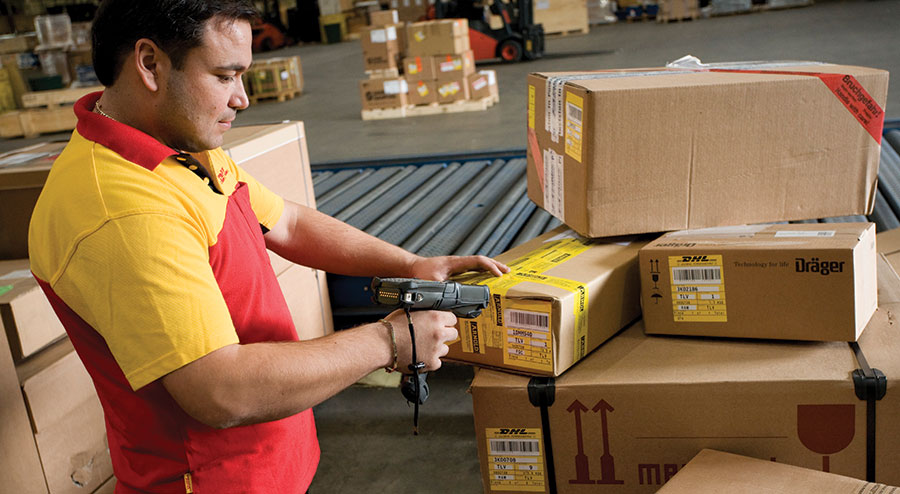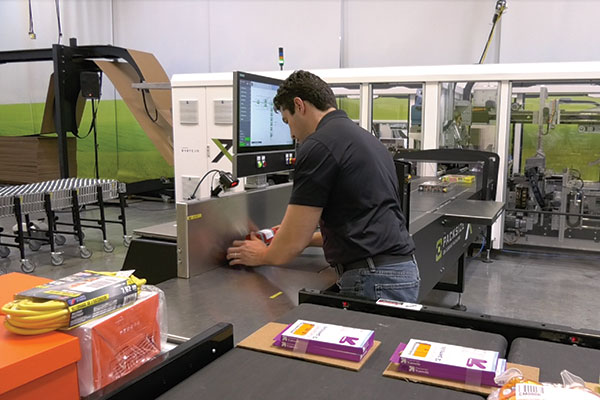Software Drives Automated Packaging Efficiencies
With the growth of e-commerce, more operations are turning to automated packaging to keep pace with order fulfillment volumes and shipment cut off times. Find out the role software plays in governing the flow of the packaging process and using dimension and weight data to save on shipping costs.
Picking items and packing items are at the crux of warehouse operations. They are the yin and yang of fulfillment, yet on the technology side, much of the attention goes to order picking technology like autonomous mobile robots (AMRs) and goods-to-person order picking systems.
Packaging, however, is gaining interest due to the nature of e-commerce. Packing items for small orders is labor-intensive if done manually, which raises interest in finding packaging efficiencies. In fact, according to a survey last year by logistics company DHL, nine of 10 companies say packaging will play an important role in the next three to five years.
When it comes to pack out of small orders in a distribution center, various types of automated approaches are available, from semi-automated pack stations to more fully automated pack out lines. The highly automated solutions may include various subsystems, such as in-line weighing or dimensioning equipment, carton rightsizing automation, autobagging, print-and-apply units, document insertion, scanning and image capture, and carton sealing automation.
It takes software and accurate data to have all these pieces of automation work as one. Not only does the software trigger each function when needed, software for automated packaging also may need to address management of weight and dimension (DIM) data, cartonization logic (figuring out the optimal size carton for each order and its contents), and freight rate shopping for individual shipments.
These packaging needs elevate the importance of software, both from vendors who specialize in automated packaging and broader-based suppliers who offer warehouse execution system (WES) or warehouse control system (WCS) software. The role of software in automated packaging thus has both a tactical control purpose and strategic objectives, notes Tim Krisher, vice president of sales with New Dawn Supply Chain, a sister company to Conveyco Technologies, a warehouse systems integrator.
“With automated packing solutions, you’re also trying to reduce freight costs, and you’re trying to get more packages out the door using less space, while freeing up labor,” says Krisher.
Packaging elements
The tricky thing about the software needs of automated pack out lines, explains Krisher, is that systems and subsystems vary widely. Elements might include in-line dimensioning, or rate shopping, but in some cases not. Some solutions are more fully automated, others just have some automated functions. “Automated packaging systems vary as much as automobiles,” says Krisher. “Just like cars, they are all over the place in terms of capabilities.”
Packaging solutions also vary by function. There is primary and secondary packaging, sometimes performed in a DC or by a third-party logistics (3PL) facility. This type of packaging is often a value-added service in which packaging configurations or end-of-aisle displays are produced for shipment to retailers.
As a major 3PL, DHL Supply Chain handles both primary and secondary packaging for clients, as well as pack out for e-commerce orders. Both types of packaging involve software considerations, says Alicemarie Geoffrion, vice president of packaging solutions for DHL Supply Chain, North America.
For primary packaging, where a company needs to generate special packaging for retailers, the software capabilities need to extend to upstream considerations like demand planning and materials planning, says Geoffrion, both for the goods or “feeder stock” to be packaged, and packaging materials like corrugated stock or labeling and sealing supplies. DHL Supply Chain uses Cloud-based tools for these upstream planning processes, says Geoffrion, and once plans are established, WMS software manages the inventory in the four walls of the DC.
“We leverage software-as-a-service to manage the planning aspects of what we do and integrate that with WMS to then manage the material flow,” says Geoffrion. “It is more of an end-to-end supply chain process that goes pretty far upstream to when our clients are designing the packaging.”
DHL Supply Chain also can provide pack out of e-commerce orders. The software considerations here include managing the distinct pieces of automation in pack out lines, such as weigh scales or print-and-apply, while also managing the overall flow of work coming into pack out lines from systems like conveyor/sortation or order picking systems, explains Michael Copeland, IT director for DHL Supply Chain, North America.
“There are load balancing considerations you want to be able to address so you can maintain the needed throughput levels and make sure you’re getting orders out the door as efficiently as possible,” says Copeland.
Copeland advises that while companies can start out by using control software provided by packaging automation vendors, the larger the fulfillment operation, the more sophisticated the software needs to be in terms of being able to load balance all the zones of automation while ensuring the automated pack out lines get high utilization.
This might involve software capabilities at the WES level, integrated with WMS for order data and master data, and with controls for pack out automation. “If you don’t have your systems connected, it’s very difficult to be agile and scalable,” says Copeland.

The pressing need to hit tight shipment windows makes avoidance of bottlenecks in packaging a growing concern.
Overall facility flow
Solution providers who offer WES point out that WES capabilities can help keep automated pack out stations in sync with other zones of automation like put walls and conveyors that are feeding completed orders to pack out.
“We can pull in information from all automated systems, including packing system elements,” says Dann Woellert, a product manager with Matthews Automation Solutions, which offers WES software and also helps deploy packaging solutions. “Whether it’s activity and data from conveyor/sortation, or from a put wall system, we can pull all of that data into WES to make forward-looking decisions to control the overall flow for the operation and ensure everything is running efficiently.”
Woellert sees automated packaging as a growing area of need because of the labor it can save versus trying to manually pack small orders. “With the rise of e-commerce and omni-channel fulfillment, that is putting a lot of focus on automated packaging, and not just for controlling all elements in the pack out area, but also keeping the flow of the warehouse in balance and addressing the rightsizing of packages,” says Woellert.
Having automated packaging integrated with WES plugs the packaging line into the WES’s orchestration logic to support a smooth flow of work, says Mary Elliot, chief product and technology officer for Fortna, a warehouse automation integrator and WES provider. “By having automated packaging more fully integrated with WES, you can utilize the WES intelligence layer to achieve optimized throughput,” says Elliott.
It’s possible to have a more basic integration to controls for packaging automation whereby the WES gets updates from packaging system controls, but Elliott adds that with a fuller integration, “you’ll be better able to balance the workflow and ensure you’re not getting bottlenecks.”
Rightsizing and DIMs
The rightsizing of packages with an automated packaging system is a data-driven proposition. While some vendors offer equipment that “rightsizes” cartons for each order based on order contents and overall cubic volume, that equipment needs data and software logic to work its magic, says Jeremy Keith, software integration engineering manager for Packsize International, a provider of on-demand packaging systems that do rightsizing.
Again, since DC automation and material flows may vary widely even within one company, the solution approach to rightsizing will vary, explains Keith. Some sites have good DIM and weight data that can be tapped into and managed as part of the rightsizing solution, but others will need dimensioners in the pack out line or some other point in the material flow like upstream at receiving. “We recognize that our customers have widely varied process flows, so we put together a process flow for our solutions that works well with what they have, or, if their process flow needs some improvement, we can act as consultants to improve that process flow,” says Keith.
Rightsizing also benefits from software logic and rules for other packaging attributes besides weight and DIM, adds Jeff Rasmussen, a leader in Packsize’s software development team. “What we’ve found in working with customers is that there are other important attributes like the fragility of an item that can have a significant impact on the packaging decision,” he says. “Hazardous materials would be another, as well as nesting and stacking of items, which refers to how many items can be stacked together, and how that group of items grows as you add another item to the stack. There are multiple attributes that we account for.”
Integrators of automated pack out lines work closely with users to determine the best place to locate pack-out functions or subsystems. Some dimensioning, for example, might be best done in receiving. Conveyco’s Krisher also advises that rate shopping be triggered as far upstream as possible within the pack out line sequence, to provide for adequate response time before the shipping label needs to be generated.
In short, package rightsizing is much more than the piece of equipment that cuts, folds and spits out the right size box. Software logic that considers package attributes and effective capture and management of weight and DIM data is essential, says Keith. “It seems simple, but there is a lot of complexity involved with cubing and instantly figuring out what the smallest carton that items can fit inside of and be safely shipped to the customer,” he says.
Perfect packaging
Software automated packaging also needs to be adept at integrating to host systems that hold order requirements, in addition to various types of automation such weigh scales or print-and-apply units within the pack station.
By knowing the order details, the packaging software can accurately govern the placement of all of the documentation and collateral that should go into each customer order and trigger all the steps, says Tom Napier, product manager for automated pack stations with PSI Engineering, a vendor of automatic pack station solutions.
“To have a complete, accurate order, there are numerous items that may need to go into a package besides the products ordered by the customer, and it all has to happen in a timely manner,” says Napier. “These extra items often include the packing slip, a shipping label, a shipping label pouch, or extra collateral like coupons, samples, assembly instructions or maybe even a greeting card. These items vary by customer order, so the software needs to be able to manage all the transactions that need to take place.”
In effect, it is software that manages the intricate dance of automation occurring in pack out lines, such as on-demand printing, weighing, dimensioning, package rightsizing, sealing automation, or automatic image capture with a fixed position camera.
“The software for an automated pack station ensures that everything that needs to go into each package gets placed in there, in the correct way, by both automated or semi-automated means,” says Napier. “It’s transactional software that results in an accurate and fast packing process.”
There’s also a customer experience and upselling aspect to pack station solutions, in that an automated station can include features like a printer to customize greeting cards on demand, or ensure that any special protective packaging or void fill is properly placed, says Napier.
“There are key upstream steps involved in an accurate order, but if you are talking about a perfect order—which means all the ordered items and collateral are complete and the goods arrive damage free—then an automated pack station and its software is what allows the final parts of that process to take place,” says Napier.













